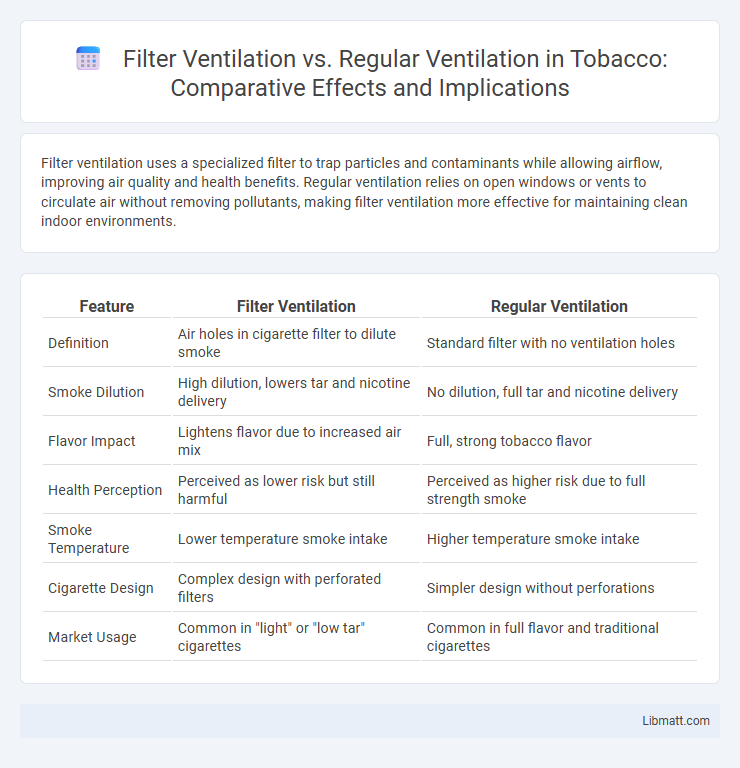Filter ventilation uses a specialized filter to trap particles and contaminants while allowing airflow, improving air quality and health benefits. Regular ventilation relies on open windows or vents to circulate air without removing pollutants, making filter ventilation more effective for maintaining clean indoor environments.
Table of Comparison
| Feature | Filter Ventilation | Regular Ventilation |
|---|---|---|
| Definition | Air holes in cigarette filter to dilute smoke | Standard filter with no ventilation holes |
| Smoke Dilution | High dilution, lowers tar and nicotine delivery | No dilution, full tar and nicotine delivery |
| Flavor Impact | Lightens flavor due to increased air mix | Full, strong tobacco flavor |
| Health Perception | Perceived as lower risk but still harmful | Perceived as higher risk due to full strength smoke |
| Smoke Temperature | Lower temperature smoke intake | Higher temperature smoke intake |
| Cigarette Design | Complex design with perforated filters | Simpler design without perforations |
| Market Usage | Common in "light" or "low tar" cigarettes | Common in full flavor and traditional cigarettes |
Introduction to Cigarette Ventilation
Cigarette ventilation involves tiny holes in the filter that mix air with smoke, reducing tar and nicotine intake compared to regular ventilation without holes. Filter ventilation improves airflow and cools smoke, enhancing the smoking experience by making it lighter and less harsh. Studies indicate that while ventilated filters reduce tar yields on machines, smokers often compensate by inhaling more deeply, impacting actual exposure.
Understanding Filter Ventilation
Filter ventilation strategically integrates tiny perforations in the cigarette filter, blending smoke with air to reduce tar and nicotine delivery while maintaining draw resistance. This design aims to lower harmful substance intake without compromising smoker satisfaction, distinguishing it from regular ventilation which lacks these precise air dilution mechanisms. Understanding filter ventilation highlights its role in controlling smoke composition and influencing smoker exposure compared to traditional filter methods.
What is Regular Ventilation?
Regular ventilation refers to the traditional method of airflow management in cigarette filters, where small holes or perforations allow air to mix with smoke, reducing tar and nicotine intake. Unlike filter ventilation, which often involves engineered materials to control airflow precisely, regular ventilation relies on simple mechanical perforations without advanced filtering technologies. This approach helps moderate smoke intensity but is less effective in optimizing smoke dilution and flavor compared to specialized filter ventilation systems.
Key Differences Between Filter and Regular Ventilation
Filter ventilation incorporates tiny perforations in cigarette filters that dilute smoke with air, resulting in a smoother taste and reduced tar intake. Regular ventilation lacks these perforations, delivering raw smoke concentration without dilution, which can intensify flavor but increase harmful substance exposure. Your choice between them impacts the smoking experience's intensity, health risks, and flavor profile.
Impact on Smoke Composition
Filter ventilation significantly alters smoke composition by diluting mainstream smoke with air, reducing tar, nicotine, and carbon monoxide levels in each puff compared to regular ventilation. Regular ventilation lacks this dilution mechanism, resulting in higher concentrations of harmful chemicals and particulate matter in the smoke. Consequently, filter ventilation changes the combustion temperature and smoke chemistry, potentially affecting the smoker's exposure to toxicants.
Health Implications for Smokers
Filter ventilation reduces tar and nicotine intake by diluting smoke with air, potentially lowering immediate exposure to harmful chemicals. Regular ventilation lacks this feature, resulting in higher concentrations of toxic substances in the smoke you inhale. Your health risks, including respiratory diseases and cancer, may be influenced by the type of ventilation system used in cigarettes.
Influence on Smoking Behavior
Filter ventilation in cigarettes reduces perceived smoke harshness by diluting the smoke with air, which often leads smokers to inhale more deeply or smoke more cigarettes to achieve desired nicotine intake. Regular ventilation lacks this dilution effect, typically resulting in a stronger, harsher smoke that may limit compensatory smoking behaviors. Studies show filter ventilation can inadvertently increase total smoke exposure due to these changes in smoking patterns despite the initial intent to reduce harm.
Regulatory Considerations and Standards
Regulatory considerations for filter ventilation and regular ventilation primarily focus on their effectiveness in controlling emissions and ensuring indoor air quality standards. Filter ventilation systems often require compliance with stricter regulations such as HEPA or ULPA certification to meet air filtration efficiency criteria, while regular ventilation must adhere to building codes and standards like ASHRAE 62.1 for adequate airflow and pollutant dilution. Your choice between the two should align with local regulatory guidelines to ensure safety, performance, and legal compliance in ventilation design.
Technological Advances in Ventilation Design
Technological advances in ventilation design have significantly improved the effectiveness of both filter ventilation and regular ventilation systems. Filter ventilation incorporates micro-perforated filters that reduce harmful smoke intake by selectively controlling airflow, enhancing user safety without compromising draw resistance. Regular ventilation, often featuring unfiltered air inlets, relies on improved aerodynamics and material innovations to optimize airflow and reduce toxic exposure, giving your smoking experience better regulatory compliance and reduced health risks.
Future Perspectives on Cigarette Ventilation
Future perspectives on cigarette ventilation highlight advancements in filter ventilation designed to reduce harmful smoke constituents more effectively than regular ventilation. Innovations focus on optimizing airflow and chemical filtration to minimize tar and nicotine intake, enhancing smoker safety without compromising flavor. Your choice between filter and regular ventilation may influence exposure to toxins as research continues to evolve in this critical area of tobacco product development.
Filter ventilation vs Regular ventilation Infographic

 libmatt.com
libmatt.com